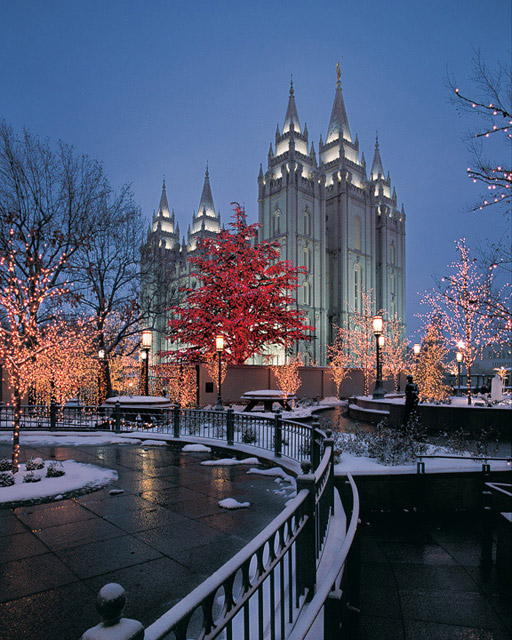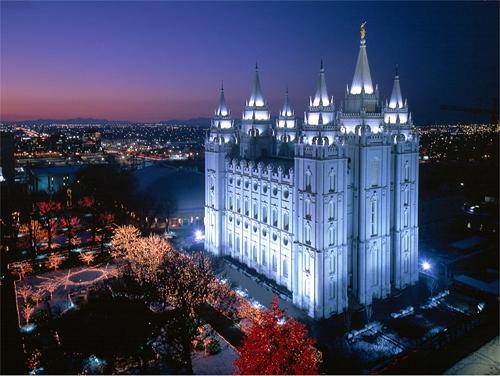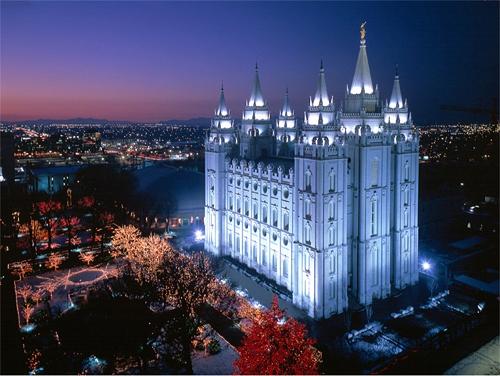 Elder James Talmage has given us a thorough description of Zion in his book on the Articles of Faith. (To read it, click here.) The city of Zion will be a New Jerusalem on the American continent, wherein the righteous will gather. It will be one of two great religious centers (with Jerusalem in the Holy Land being the other) during the Millennium. Zion is also defined as “the pure in heart.” A common theme in Mormonism is turning away from “Babylon,” which represents worldliness and sin, toward Zion, or righteousness and devotion to God. The following is a personal reflection of Mormon Church member Marie, who was, at the time she wrote this, a student at the BYU Jerusalem Center for Near Eastern Studies and a member of the Jerusalem Branch of The Church of Jesus Christ of Latter-day Saints:
Elder James Talmage has given us a thorough description of Zion in his book on the Articles of Faith. (To read it, click here.) The city of Zion will be a New Jerusalem on the American continent, wherein the righteous will gather. It will be one of two great religious centers (with Jerusalem in the Holy Land being the other) during the Millennium. Zion is also defined as “the pure in heart.” A common theme in Mormonism is turning away from “Babylon,” which represents worldliness and sin, toward Zion, or righteousness and devotion to God. The following is a personal reflection of Mormon Church member Marie, who was, at the time she wrote this, a student at the BYU Jerusalem Center for Near Eastern Studies and a member of the Jerusalem Branch of The Church of Jesus Christ of Latter-day Saints:
As we move through mortality, we are completing an essential step in our spiritual progression to become like our Heavenly Father. Life on earth is a central place of spiritual growth, stuck in the midst of eternity. Our spiritual growth here can be described as an immigration of sorts, as we pick up and move in humility, wherever the Lord directs. With each small decision, we draw closer to either Zion, the Lord’s domain, or to Babylon, the world’s influence. However, though we are commanded to progress spiritually toward an ideal Zion, defined as the community of the pure in heart, earth life is a physical existence. Mortality means having a physical body and every weakness included therein. Because of this, our Heavenly Father often operates on a physical or temporal level with His children, in order that we may understand.
As we make covenants, we perform physical ordinances such as baptism, which involves physical action. The Israelites in the Old Testament came up out of Egypt and wandered in the wilderness, struggling to obey the Lord’s command, a great physical immigration symbolizing the Lord’s covenant with His chosen people. The Lord often asks us to move physically so that we may increase spiritually… which is part of the reason I am here studying in Israel, I think.
In Mosiah 18 of the Book of Mormon, the prophet Alma has formed a church in the outskirts of King Noah’s city, even a place called Mormon. The members have been baptized and have covenanted to “mourn with those that mourn, and comfort those that stand in need of comfort.” And in verse 30, it says, “And now it came to pass, that all this was done in Mormon, yea, by the waters of Mormon, in the forest that was near the waters of Mormon; yea, the place of Mormon, the waters of Mormon, the forest of Mormon, how beautiful are they to the eyes of them who there came to the knowledge of their Redeemer….” What this scripture meant to me, originally, is that I would always love the place I call home in California, because it was there that I first came to the knowledge of my Redeemer, Jesus Christ. But I didn’t stay home, just as Alma’s people did not long stay in Mormon. The Lord was not content with this small spiritual step in these first beautiful places. But then I thought, don’t we come to a new knowledge of our Redeemer continually? Ideally, anyway. Shouldn’t every day and each new place bring a new testimony and a new sense of beauty? If the Lord had allowed the people of Alma to stay in Mormon, or if He had allowed me to stay in California, we might still be working off of our initial testimony of baptism, which is really only the gateway to the rest of God’s eternal plan. And we would only see the beauty of our homes, and miss so much more.
I think that change of place, physical movement as a humble response to the Lord’s promptings, is sometimes essential. As we move to a new place, physically, by the Lord’s command, we learn humility. Our earthly perspective shifts, like rocks in a jar, and a new, clean, heavenly perspective fills in the gaps, like sand. A mission might provide this shift in perspective. For me, coming to Israel is providing one of many shifts of earthly perspective in my life. Any place can do this. Any place can become beautiful to us by the extension and expansion of personal testimony that occurs there. That being said, it is important to note, as one of my classmates, Emma, suggested, that changing location does not necessarily change your heart. It may change the way you look at things, but you must change your heart. First open it, break it, then let Christ heal it and make you new. This change of heart often requires repentance, or as Elder Neil L. Andersen of the Quorum of the Twelve Apostles puts it, a “re-turning” toward Christ. “When we sin, we turn away from God. When we repent, we turn back toward God.” This is as physical a description as any of the spiritual process of repenting. Again, we turn toward Zion instead of Babylon. We try to “ … reach up to a higher way of life, to change, and to feel the happiness of keeping the commandments. Being disciples of Christ, we rejoice in the blessing of repenting and the joy of being forgiven. They become part of us, shaping the way we think and feel.”
In 3 Nephi in the Book of Mormon, as the resurrected Christ comes to the Americas at the close of His mortal ministry, he pleads with the people, “O all ye that are spared because ye were more righteous than they, will ye not now return unto me, and repent of your sins, and be converted, that I may heal you”? (3 Ne. 9:13) Sometimes it is true that others may not understand where we have been, and still less how we might feel. “But,” says Elder Andersen, “there is One who does. He knows. He has felt your pain. He has declared, ‘I have graven thee upon the palms of my hands.’ The Savior is there, reaching out to each of us…” in order to lift, heal, and ultimately exalt.
Emma is right. Changing location physically does not necessarily change your heart. But obedience often entails a physical change of location that facilitates a spiritual change of location, which humility often leaves us yearning for the healing and enlarging power of our Savior’s atonement. So, it is important that we recognize the benefit of a sort of physical pilgrimage, as our Father in Heaven directs. Yet although I am here in the Holy Land, a huge physical change for me, and there are missionaries serving all over the world in humility, and the Israelites came up out of Egypt unto Israel, and Nephi traveled to the promised land, and the Latter-day Saints crossed the plains to the Salt Lake Valley, and Joseph Smith placed himself in the Sacred Grove where sincere prayer brought a vision that changed the world, the Lord’s simple command that applies to all is merely the invitation for a small, perhaps fractional pilgrimage: “Stand ye in holy places.”
 As I mentioned before, almost any place can accomplish the spiritual turning toward Zion that we all need. Our homes, our church meetinghouses, the Mormon temples, and maybe other places that may be more extraordinary to our routines. But, the factor of extraordinary is not essential. In 1 Kings 19:11-12 it reminds us of this: “And behold, the LORD passed by, and a great and strong wind rent the mountains, and brake in pieces the rocks before the LORD; but the LORD was not in the wind: and after the wind, an earthquake; but the LORD was not in the earthquake: And after the earthquake a fire; but the Lord was not in the fire: and after the fire a still small voice.”
As I mentioned before, almost any place can accomplish the spiritual turning toward Zion that we all need. Our homes, our church meetinghouses, the Mormon temples, and maybe other places that may be more extraordinary to our routines. But, the factor of extraordinary is not essential. In 1 Kings 19:11-12 it reminds us of this: “And behold, the LORD passed by, and a great and strong wind rent the mountains, and brake in pieces the rocks before the LORD; but the LORD was not in the wind: and after the wind, an earthquake; but the LORD was not in the earthquake: And after the earthquake a fire; but the Lord was not in the fire: and after the fire a still small voice.”
The Lord is in the still small voice. The holy spirit comes and blesses our lives as we invite it. Standing in holy places helps us to desire this gift of Zion, and helps us to abandon Babylon more fully. Standing in holy places may open our hearts to the store of revelation that the Lord is all too eager to bestow upon us. Elder Richard G. Scott of the Quorum of the Twelve Apostles suggests: “Our Father expects you to learn how to obtain that divine help by exercising faith in Him and His Holy Son, Jesus Christ. Were you to receive inspired guidance just for the asking, you would become weak and ever more dependent on Them. They know that essential personal growth will come as you struggle to learn how to be led by the Spirit.” Thus, in our quest toward spiritual progression, we not only gradually achieve our goal of celestial standing, but we also gradually obtain the tools necessary to get there. We receive line upon line, precept upon precept, the revelations of where to go and how to get there, whether physically or spiritually. And someday we will receive revelation as to the purpose of all these things. Until then, we must humbly go and do, as Nephi did (1 Nephi 3).
I would like to share some reflections from Mormon missionaries who did just that, and found much more in the Lord’s plan for them than they thought. First, Elder Zach Call:
“I looked around me. The street was empty, the air brisk, the city silent. A 19 year old kid from Utah, standing in Sanitago, Chile, speaking a different language, yelling at houses because he wants to talk about Jesus Christ with people. How extraordinary the situation… [how it came to be] that Christ gave me the very gift I’d been trying to give Him.”
And from Elder Aaron Smith, serving in Argentina: “He has blessed me with the opportunity to change—to repent—to obtain this vision—to turn the key and open the door. He has put me here to see if I’m willing to humble myself and accept His will. And little by little, I learn a little more, his light extends a little further, and all this starts to become something I’ve never imagined.”
Ultimately, the places we go will not really matter to the Lord. He knows the end of all. He knows where we are going. He knows that even the end of the Plan of our Father doesn’t really matter—but who we are at the end does matter. We, as children of our Father, are the purpose for the entire Plan anyway. Heaven will be heaven because the Lord’s children are there, exalted. So we submit to His wisdom and His love. We kneel humbly at his feet, trying to obey with exactness. He will lift and ultimately exalt. His is the power to restore, to heal, to create. In reality, all we have to do is agree to the process of becoming ourselves, through covenants and trials that make us move.
As expressed by President Henry B. Eyring of the First Presidency of The Church of Jesus Christ of Latter-day Saints, speaking of primary children, “It seemed to me that they were not just singing; they were declaring their determination. Jesus Christ was their example. To be like Him was their fixed goal. And their eager looks and their shining eyes convinced me that they had no doubts. They expected to succeed. They believed that the instruction of the Savior to be perfect was not a hope but a command. And they were sure He had prepared the way.”
Jesus Christ has prepared the way. And though we may each follow slightly different itineraries moving through mortality, our destination is the same. All the holy places in which we stand, all the commandments which we follow, and the covenants we hold will all lead us to one destination that is not physical nor locational, but rather spiritual and celestial. It is who we will be. It is the final realization of Zion and the emptiness of Babylon. It is the most beautiful image given by Book of Mormon prophet Moroni 7:48: “Wherefore, my beloved brethren, pray unto the Father with all the energy of heart, that ye may be filled with this love, which he hath bestowed upon all who are true followers of his Son, Jesus Christ; that ye may become the sons of God; that when he shall appear we shall be like him, for we shall see him as he is; that we may have this hope; that we may be purified even as he is pure. Amen.” I know that we can be like Him. That is our Father’s work. Of this I testify in the name of Jesus Christ, amen.





